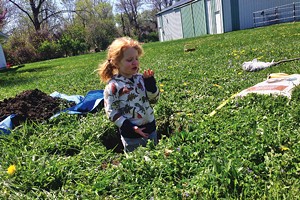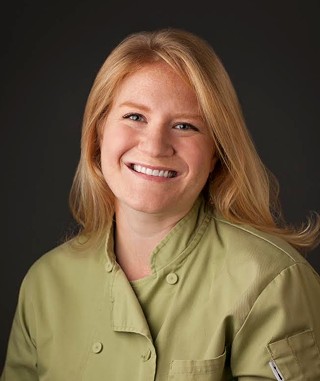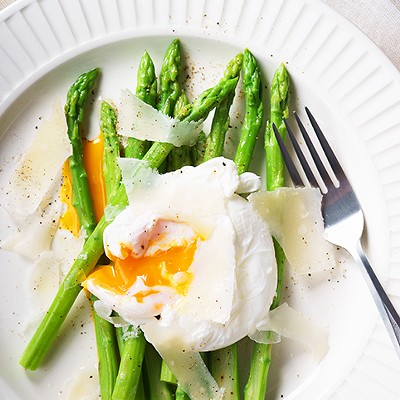I have vivid memories of wandering through the thousands of tomato plants that were grown on my great-grandfather’s market farm. Lima beans were a delicacy in our family. When they were in season I played in the shade of the giant sycamore tree beside my grandmother’s house while she, my mother and my great-grandmother sat on the porch shelling the plump pods. We always made sure to to freeze enough homegrown limas and sweet corn so that they could grace our table at Thanksgiving and Christmas. As a child I had no idea how extraordinary this multigenerational ritual truly was, and I took for granted the fact that food came from the earth, and that it took a lot of labor and love to bring it to our plates. Now as a mother myself, I am grateful that my own daughter, Maddie, is able to experience the joy and sense of connection that comes with raising and eating one’s own food.
As I talk to families in my role as chef for a nonprofit working to improve the nutrition and fitness of children in our community, I continue to be struck by the degree to which the relationship between the food we consume and our health and environment has become so attenuated in the minds of many children, as well as adults. It has all but vanished. I have to remind myself that my own upbringing was decidedly atypical in this respect, and that had a profound effect on my food and lifestyle choices.
There is just one problem: Back when my great-grandparents were living in the house which I now occupy, there were four adults working the garden, and three generations of women were there, ready to process the bushels that came in from the field, overflowing with peas, tomatoes, corn and limas. Today, it’s a little more quiet around here, and our time and resources are much more limited. I realized that if I wanted Maddie to experience getting her hands dirty, I’d have to do things a little differently than my forebears.
“Gardening is hard work, and there are no shortcuts,” says veteran gardener and GenHKids’ farmer and garden educator, Andy Heck. That said, making smart choices when planning your garden can save a lot of time on the back end and, in any event, you will be rewarded for taking care to do it right.
Raised beds, which are attractive, easier to weed and relatively impervious to excessive rain or periods of drought can be made out of wood, cinder blocks or even straw bales or used tires, and can even be set up on asphalt. There are countless plans available online for constructing raised beds out of 2x4 planks. Ideally the soil in the area within the bed should be turned over with a fork to break up the surface of the sod.
At this point, Heck recommends filling the beds with top quality weed-free compost, an investment that will ultimately save lots of time and backaches. When properly composted, the naturally occurring heat kills all the weed seeds, and the resulting humus is a nutrient-rich “black gold.” Heck recommends Peoria-based Better Earth Compost, whose pumpkin-based compost is locally available, in bags or in bulk, at Pleasant Nursery.
When selecting seeds and plants for your garden, don’t be too hasty. “Lots of people want to put their tomato plants in too soon, but there’s nothing wrong with waiting until the end of May or even June before transplanting tomato, eggplant and pepper plants into the garden,” says Heck. Plants started outdoors too early, when temperatures are still variable, can often become weak, leggy and ultimately less productive.
Succession planting is useful in maximizing productive space in a garden. For example, lettuces and green onions can be sown first in a bed in April, followed by tomatoes and basil at the end of May, then lettuces, spinach, watermelon radishes and peas in August. Diversity in the garden also helps to reduce incidence of disease and to maintain good soil nutrition.
For those interested in gardening but who lack the time, knowledge or space to put in a garden of their own, community gardens are an ideal way to get your hands dirty. Grow Springfield, an organization committed to increasing access to fresh, wholesome, sustainably grown food in the Springfield area, lists various community gardens throughout the city on its website www.growspringfield.org.
Some gardens are known as collaborative gardens, where the gardens are managed by a gardener, and members of the community are welcome to plant, work and harvest as they choose. GenHKids’ community garden at Third and Canedy, which Heck manages, has group work days every Monday and Thursday 5-7 p.m. during the growing season and provides an ideal opportunity for new or curious gardeners to work alongside experienced gardeners and develop their own “green thumb.”
In addition to the myriad ways gardening benefits the health of the gardener and of the community, the act of plunging a trowel into the soil and planting something that will grow and nourish people is deeply satisfying, as is the rare sense of connectedness that it engenders.
Ashley Meyer is the executive chef and Eat Real Educator for the genHkids’ coalition. When she’s not educating Springfield families about the benefits of fresh food and how to cook it, she’s passing on her love of gardening and nature to her three-year-old daughter, Madeline Rose.




















